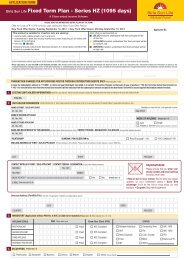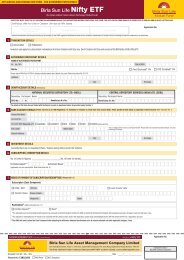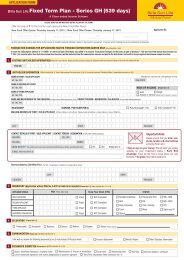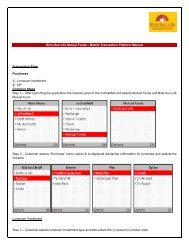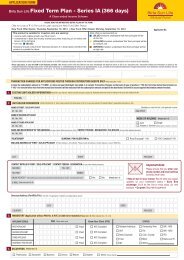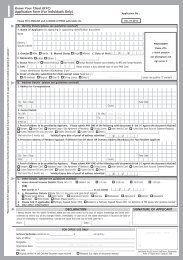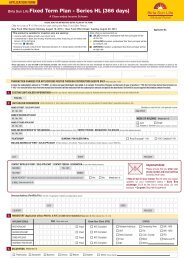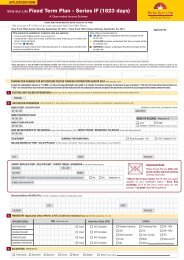Connect for the Month of March 2007 - Birla Sun Life Mutual Fund
Connect for the Month of March 2007 - Birla Sun Life Mutual Fund
Connect for the Month of March 2007 - Birla Sun Life Mutual Fund
You also want an ePaper? Increase the reach of your titles
YUMPU automatically turns print PDFs into web optimized ePapers that Google loves.
M a r c h 2 0 0 7<br />
Market Outlook<br />
EQUITY MARKET<br />
Equity markets remained volatile over last month owing to tightening liquidity and higher inflation. Union Budget expectations and state election results added to <strong>the</strong><br />
confusion.<br />
As <strong>the</strong> month closed, <strong>the</strong> Finance Minister, Mr. Chidambaram cleared <strong>the</strong> dust laying all speculations to rest. Key<br />
positives in <strong>the</strong> budget include strong focus on infrastructure (urban & rural), agriculture and education. The budget<br />
provides <strong>for</strong> increased (+30-32%) spending on 'Bharat Nirman', rural electrification and higher outlay <strong>for</strong> <strong>the</strong> Rural<br />
Infrastructure Development <strong>Fund</strong>. Social spending allocation has also been raised by 36% <strong>for</strong> improvement <strong>of</strong><br />
general education, public health and social security. Agriculture push remains with outlay on irrigation raised by<br />
55% in addition to promise <strong>of</strong> re<strong>for</strong>ms in fertilizer subsidy delivery mechanism.<br />
The government also maintained <strong>the</strong> pace <strong>of</strong> trade liberalization with reduction in peak rate <strong>of</strong> customs duties from<br />
12.5% to 10% on non-agricultural imports. As has been <strong>the</strong> case with earlier budgets, service tax net has been<br />
fur<strong>the</strong>r widened to include more services. However, direct tax rates have not been tinkered with even after record<br />
tax collections. In fact, Education Cess stands increased by an additional percent while dividend distribution tax<br />
has been raised to 15%. This clearly indicates <strong>the</strong> FM's disposition towards using revenue growth to maintain fiscal<br />
discipline in comparison to expenditure control.<br />
The budget did not contain any positive surprises <strong>for</strong> <strong>the</strong> corporate sector. Certain measures, viz. imposition <strong>of</strong> FBT on ESOPs, differential excise duty on cement<br />
producers (arguably directed to cap cement prices) cannot be termed progressive. Though, <strong>the</strong>re has not been<br />
a significant impact on corporate earnings, certain tax proposals could negatively impact earnings <strong>for</strong> few<br />
companies in some sectors viz., 15-25% <strong>for</strong> Construction sector on account <strong>of</strong> withdrawal <strong>of</strong> 80IA benefit, 15-<br />
20% <strong>for</strong> Mining sector due to imposition <strong>of</strong> export tax on iron ore and 2-5% on IT sector from application <strong>of</strong> MAT.<br />
In terms <strong>of</strong> fiscal situation, Centre's own per<strong>for</strong>mance has been quite satisfactory as it adhered to fiscal<br />
discipline and managed to restrict <strong>the</strong> fiscal deficit to 3.6% <strong>of</strong> GDP, thanks to 38% growth in Net Tax Revenue to<br />
<strong>the</strong> Centre <strong>for</strong> <strong>the</strong> Apr-Dec'06 period.<br />
Advance Estimate numbers suggest that <strong>the</strong> growth in Agricultural sector is at 2.7% as against 10.0% in<br />
Industrial sector and 11.2% in Services. Undeniably, <strong>the</strong> slow growth in agricultural sector is a worrisome<br />
aspect in current state <strong>of</strong> affairs. With almost two-third <strong>of</strong> <strong>the</strong> population dependent on this sector, low growth<br />
has serious implications in terms <strong>of</strong> widening income disparity. Moreover, we have already seen <strong>the</strong> impact in<br />
terms <strong>of</strong> food article inflation rise to double-digit levels on account <strong>of</strong> supply-side problems in such essential<br />
commodities. Finding short-term solutions to this problem, which affects millions <strong>of</strong> consumers, is a difficult task. Massive investments are needed to augment<br />
agricultural supply chain given that a substantial part <strong>of</strong> agri-produce in India is spoilt or wasted. Gains from <strong>the</strong>se investments would directly add to supplies<br />
Inflation has been an area <strong>of</strong> concern to most Central Bankers who have resorted to liquidity tightening in order to moderate it. The global liquidity tightening could lead<br />
to reassessment <strong>of</strong> risk appetite <strong>of</strong> investors and consequently impact flows to <strong>the</strong> various markets. Commodity markets were <strong>the</strong> first to experience volatility on this<br />
account.<br />
Lately, global equity markets have also started feeling <strong>the</strong> jitters as Bank <strong>of</strong> China raised reserve ratio by 50 bps to 10%; Bank <strong>of</strong> Japan also recently raised interest<br />
rates by 25 bps to 0.50%. Japanese Yen also appreciated from 121 to 116 recently.<br />
Indian corporate earnings have shown robust growth in first nine months as exhibited by 34% rise in Sensex earnings. Going <strong>for</strong>ward, <strong>the</strong> Sensex EPS is estimated to<br />
be Rs. 811 <strong>for</strong> FY08E even after a downward revision on account <strong>of</strong> impact <strong>of</strong> tax measures introduced in <strong>the</strong> budget. Although <strong>the</strong>re could be short-term fluctuations in<br />
<strong>the</strong> Indian equity markets, sectors directly linked to India's consumption and development prospects should do well over <strong>the</strong> longer term.<br />
DEBT MARKET<br />
Domestic Bond Markets<br />
Confluence <strong>of</strong> many unfavourable factors like surprise CRR hike, inflationary concerns, spike in global oil prices and pre-budget jitters swayed yield movements. The<br />
rise in yields was more pronounced at <strong>the</strong> short-end <strong>of</strong> <strong>the</strong> curve, <strong>the</strong> 91-day commercial paper reference rate rose sharply from 9.35% to 10.75%. The yield on <strong>the</strong> 10-<br />
year benchmark paper spiked to an intra-month high <strong>of</strong> 8.12% be<strong>for</strong>e closing <strong>the</strong> month at 8.00%. It had closed at 7.73% in January.<br />
With several economic data pointing towards record growth, high inflationary risks restrained market activity early in <strong>the</strong> month despite improving cash surpluses. Even<br />
though <strong>the</strong> RBI's hawkish stance to combat inflation kept traders vigilant, its instantaneous action <strong>of</strong> hiking <strong>the</strong> CRR (Cash Reserve Ratio) to rein in inflation and loan<br />
growth caused to heavy selling. Market momentum was fur<strong>the</strong>r hit by <strong>the</strong> above-trend inflation (consistently above <strong>the</strong> 6.00% mark), which raised beliefs <strong>of</strong> ano<strong>the</strong>r<br />
round <strong>of</strong> monetary tightening. Value buying, with bonds at multi-month lows, however helped yields come <strong>of</strong>f highs. Fur<strong>the</strong>rmore improving systemic liquidity, import<br />
duty cuts and downward revision in fuel prices <strong>of</strong>fered some respite. The Fed Reserve Chairman Bernanke's dovish remarks on diminishing inflation concerns fur<strong>the</strong>r<br />
supported <strong>the</strong> market. Speculations <strong>of</strong> bond market friendly budget and lower borrowing programme due to buoyant revenue collections also added to <strong>the</strong> optimism but<br />
worries <strong>of</strong> a fresh round <strong>of</strong> monetary tightening from <strong>the</strong> central bank to contain quickening inflation and anxiety ahead <strong>of</strong> <strong>the</strong> Budget announcements sustained<br />
pressure on yields. Concerned by accelerating inflation, <strong>the</strong> Reserve Bank <strong>of</strong> India hiked <strong>the</strong> cash reserve ratio (CRR), <strong>the</strong> second time in two months, by 50 basis<br />
points, to 6% in two stages, <strong>the</strong> first on February 17 and <strong>the</strong> second on <strong>March</strong> 3. The impact <strong>of</strong> <strong>the</strong> hike on <strong>the</strong> economy is well evident with many banks having<br />
announced an increase in <strong>the</strong>ir deposit rate and prime-lending rate (PLR). The PLR hike is expected to lead to a slowdown in retail credit growth, and thus will help bring<br />
<strong>the</strong> inflation down.<br />
Union Budget <strong>2007</strong>-2008<br />
Union Budget, highlighted robust growth prospects and fur<strong>the</strong>r fiscal consolidation through phased removal <strong>of</strong> certain tax exemptions, measures to slow down inflation,<br />
initiatives <strong>for</strong> agriculture sector aimed at addressing supply side constraints, infrastructure and <strong>the</strong> social sector. The net borrowing programme, though largely in line<br />
with market expectations, failed to enthuse <strong>the</strong> bond market, as revised estimates <strong>for</strong> <strong>the</strong> current year are higher than <strong>the</strong> market expectations despite buoyant tax<br />
revenues. Total market borrowing is estimated at a net Rs. 1.09 trillion <strong>for</strong> <strong>2007</strong>-08, 2% up from Rs. 1.07 trillion in 2006-07. The government raised <strong>the</strong> annual ceiling <strong>for</strong><br />
market stabilization bonds (MSS) that are used to absorb excess cash in <strong>the</strong> banking system. The ceiling increased to Rs. 800 billion <strong>for</strong> FY 08, from Rs. 700 billion in<br />
<strong>the</strong> current year.<br />
Outlook <strong>for</strong> bond markets<br />
Bonds are expected to remain subdued ahead <strong>of</strong> <strong>the</strong> fiscal year-end. While <strong>the</strong> plethora <strong>of</strong> fiscal and monetary measures from <strong>the</strong> government and <strong>the</strong> central bank to<br />
tame inflation and to address overheating concerns in certain sectors is likely to provide a lid on inflation in <strong>the</strong> coming months, pressure on interest rates could continue<br />
<strong>for</strong> some time. Besides inflation, liquidity will also be closely tracked due to <strong>the</strong> quarterly tax flows and year-end demand. At this stage, investors can consider locking in<br />
funds at <strong>the</strong> higher short-term yields by investing in fixed maturity plans, floating rate and liquid funds.<br />
4<br />
Commodity 3 <strong>Month</strong>s Returns (%)*<br />
Aluminium 3M -2<br />
Copper 3M -14<br />
Zinc 3M -25<br />
Nickel 3M 21<br />
Crude Oil -3<br />
Natural Gas -14<br />
* 01-Dec-2006 to 02-Mar-<strong>2007</strong><br />
Equity Markets 2 <strong>Month</strong>s Returns (%)*<br />
India (BSE Sensex) -7<br />
USA (S&P 500) -2<br />
Nikkei 0<br />
Hang Seng -3<br />
Taiwan -2<br />
Korea -1<br />
Brazil -5<br />
UK (FTSE 100) -2<br />
* 01-Jan-<strong>2007</strong> to 02-Mar-<strong>2007</strong>



